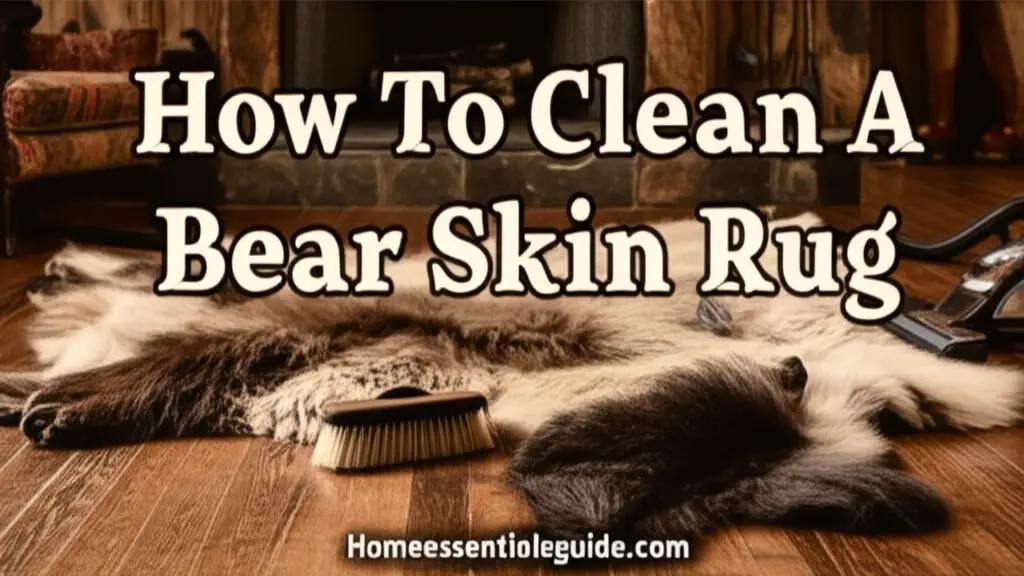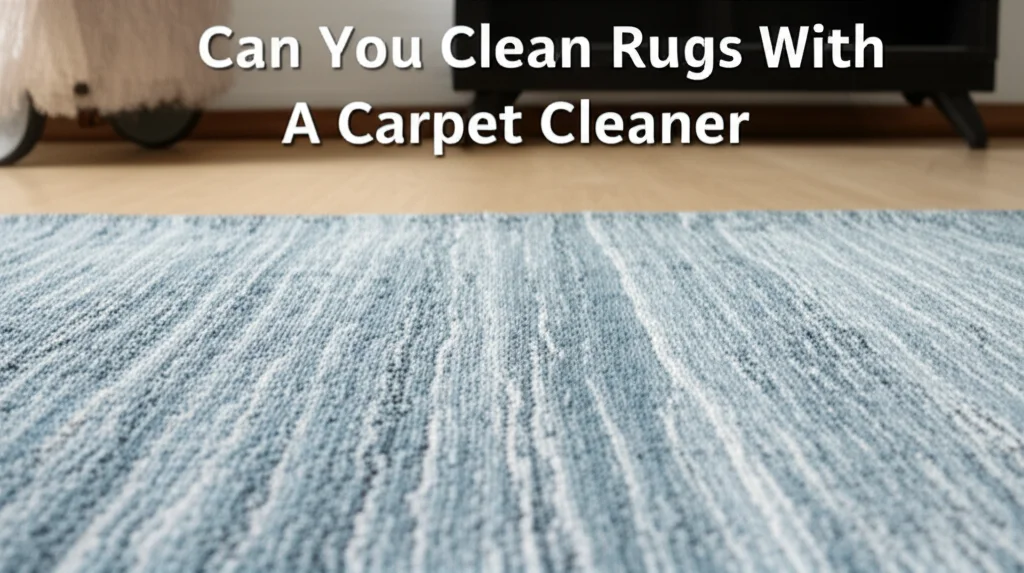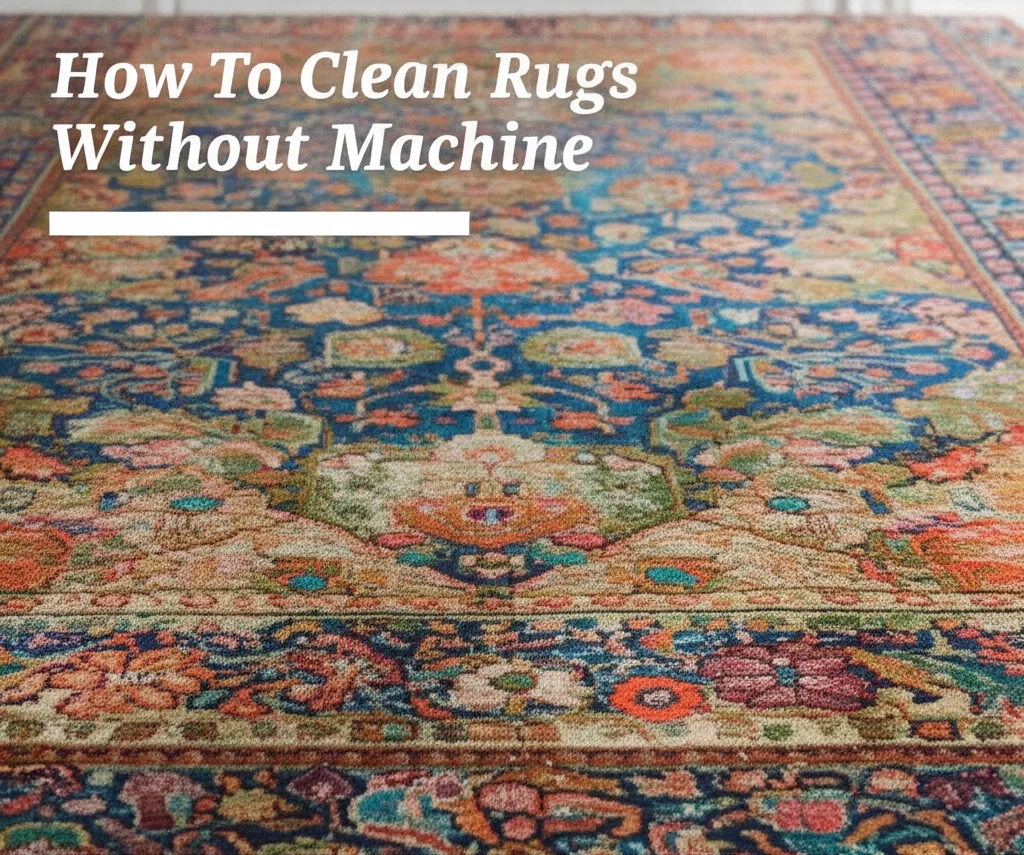· Todd Martin · Home Cleaning · 11 min read
How To Clean A Bear Skin Rug

How to Clean a Bear Skin Rug: Complete Care Guide for Preservation
A bear skin rug makes a striking centerpiece in any rustic home or cabin, but proper cleaning and maintenance are essential to preserve its beauty and longevity. Whether you’ve inherited an heirloom piece or recently acquired one, knowing how to clean a bear skin rug correctly can prevent damage and extend its life for decades.
Improper cleaning methods can lead to shedding, stiffening, or even decomposition of the hide. In this comprehensive guide, we’ll walk you through professional techniques for cleaning and maintaining your bear skin rug to keep it in pristine condition.
Key Takeaways
- Regular gentle vacuuming with a brush attachment prevents dirt buildup
- Spot clean immediately with appropriate solutions for different stains
- Never machine wash or fully submerge a bear skin rug in water
- Professional cleaning is recommended for extensive soiling or restoration
- Proper storage in climate-controlled environments extends rug lifespan
Quick Answer: To clean a bear skin rug, gently vacuum with a brush attachment on low power, spot clean stains with appropriate solutions based on stain type, brush the fur regularly to prevent matting, and have it professionally cleaned every 2-3 years for preservation.
Understanding Your Bear Skin Rug
Before diving into cleaning methods, it’s important to understand what you’re working with. Bear skin rugs consist of two main components: the tanned hide (leather) backing and the fur. Each requires different care approaches.
Types of Bear Skin Rugs
Bear skin rugs typically come from several species including:
- Black bears (most common in North America)
- Brown/grizzly bears
- Polar bears (rare and often strictly regulated)
The type of bear affects the fur texture, density, and coloration, which may influence your cleaning approach. Black bear rugs generally have shorter, denser fur, while brown bears have longer, coarser fur that may require more careful detangling.
Age and Condition Assessment
The age and current condition of your rug significantly impact how you should clean it:
- Newer, professionally tanned rugs (less than 20 years old) typically withstand more thorough cleaning
- Antique or heirloom pieces (50+ years old) require extremely gentle handling
- Check the backing for any cracking, thinning, or brittleness which indicates fragility
Examine your rug carefully before cleaning. If you notice significant deterioration, consult a taxidermy specialist before attempting any cleaning. For vintage pieces, professional cleaning services that specialize in animal hides may be your safest option.
Essential Supplies for Cleaning Bear Skin Rugs
Gathering the right tools before you begin ensures you won’t damage your prized bear skin rug during cleaning.
Recommended Cleaning Tools
- Vacuum cleaner with brush attachment and adjustable suction
- Wide-toothed fur comb or specialized pet grooming brush
- Clean white terry cloths or microfiber towels
- Soft-bristled brush for the hide backing
- Spray bottle for cleaning solutions
Safe Cleaning Solutions
For bear skin rugs, gentle is key. Avoid harsh chemicals that can damage the fur or leather:
- Mixture of cold water and mild wool detergent (1 tablespoon per gallon)
- White vinegar solution (1:3 ratio with water) for deodorizing
- Cornstarch or specialized fur powder cleaner for dry cleaning
- Leather conditioner appropriate for tanned hides
Never use bleach, ammonia, or strong detergents on bear skin rugs as these will damage both the fur and the hide backing. Also avoid hot water, which can cause shrinkage and fiber damage.
Regular Maintenance and Preventative Care
The best way to keep your bear skin rug clean is through regular maintenance that prevents deep soiling in the first place.
Weekly Maintenance
Implement these practices into your regular cleaning routine:
- Gently shake the rug outdoors (if size permits) to remove loose dirt
- Vacuum using a brush attachment on the lowest suction setting, always moving in the direction of the fur growth
- Inspect for any new stains or soiled areas
- Brush the fur with a wide-toothed comb to prevent matting
- Rotate the rug periodically to ensure even wear if it’s in a high-traffic area
Preventative Measures
Taking these preventative steps can dramatically reduce how often deep cleaning is needed:
- Place the rug away from direct sunlight, which can fade and dry out the fur
- Keep the bear skin rug away from high-traffic areas when possible
- Establish a no-shoes policy near the rug
- Avoid placing heavy furniture on the rug, which can damage the backing
- Keep pets away or supervise them carefully around the rug
Many rug owners install their bear skin rugs on walls rather than floors to preserve them longer. This approach, similar to how you might hang a Persian rug on the wall, reduces foot traffic damage while allowing the piece to remain a dramatic visual element.
How to Spot Clean a Bear Skin Rug
Despite your best efforts, accidents happen. Addressing spills and stains immediately is crucial for preventing permanent damage.
Liquid Spills and Stains
For fresh liquid spills:
- Blot (never rub) the area immediately with clean, absorbent cloths
- Once excess liquid is absorbed, prepare a solution of cold water with a few drops of wool detergent
- Dampen a clean cloth with the solution and blot the stained area
- Rinse by blotting with a clean cloth dampened with plain cold water
- Blot dry with towels and allow to air dry completely
- Once dry, gently brush the fur to restore texture
Dry Stains and Deep Soil
For dried stains or areas with built-up grime:
- Sprinkle cornstarch or specialized fur cleaning powder generously over the affected area
- Gently work it into the fur with your fingers (wearing gloves)
- Allow the powder to sit for several hours or overnight
- Vacuum thoroughly using the brush attachment
- Repeat if necessary for stubborn stains
Deodorizing Methods
Bear skin rugs can sometimes develop odors, especially in humid environments:
- For mild odors, sprinkle baking soda over the entire rug
- Let it sit for several hours or overnight
- Vacuum thoroughly with a brush attachment
- For stronger odors, lightly mist (don’t soak) with a 1:3 vinegar-water solution
- Allow to dry completely in a well-ventilated area
If dealing with pet accidents, which can be particularly problematic, you might find techniques similar to cleaning urine from polypropylene rugs helpful, though always adjusting methods to be gentler for your bear skin.
Deep Cleaning Techniques
Deep cleaning should be performed sparingly—typically once every 2-3 years or when the rug becomes noticeably soiled despite regular maintenance.
Dry Cleaning Method
The safest deep cleaning method for bear skin rugs is dry cleaning:
- Hang the rug outdoors on a line (fur side down) on a cool, dry day
- Gently beat the back of the rug to dislodge deep dirt (use a rug beater or clean tennis racket)
- Apply a generous amount of fur cleaning powder or cornstarch to the entire fur side
- Work the powder into the fur using a brush, moving in the direction of hair growth
- Allow the powder to sit overnight
- Vacuum thoroughly, still using the brush attachment on low power
- Brush the fur to restore its natural appearance and direction
Limited Wet Cleaning (For Professionals or Advanced Users)
Caution: Full wet cleaning risks serious damage and should generally be left to professionals. However, for those experienced with hide care, here’s a limited wet cleaning approach:
- Test any cleaning solution on an inconspicuous area first
- Prepare a solution of cold water and specialized hide shampoo according to product instructions
- Working in small sections, apply the foam only (not liquid) with a sponge
- Immediately blot with clean, dry towels
- Continue until the entire rug has been cleaned
- Allow to dry completely in a well-ventilated area away from direct heat or sunlight
- While drying, periodically stretch and manipulate the hide to prevent stiffening
- Once dry, brush the fur thoroughly
This method carries risks and is not recommended for valuable or antique rugs. When in doubt, professional cleaning services that specialize in natural fiber and hide products are worth the investment.
Caring for the Hide Backing
The leather backing of a bear skin rug requires different care than the fur side.
Cleaning the Backing
- Vacuum the backing using low suction without a brush attachment
- For light soiling, wipe with a barely damp cloth
- For stubborn dirt, use a soft brush and a small amount of saddle soap
- Wipe away any soap residue with a clean, damp cloth
- Allow to dry completely away from direct heat or sunlight
Conditioning the Hide
To prevent the backing from drying out and cracking:
- Once or twice a year, apply a small amount of leather conditioner formulated for taxidermy or natural hides
- Work in small amounts using circular motions
- Allow the conditioner to absorb completely
- Wipe away any excess with a clean cloth
Similar to how you would care for a cowhide rug, keeping the leather backing supple is essential for longevity.
Professional Cleaning and Restoration
Some situations call for professional expertise rather than DIY approaches.
When to Seek Professional Help
Consider professional cleaning or restoration services if:
- Your rug is an antique or particularly valuable
- The rug has extensive soiling or multiple types of stains
- The hide backing shows signs of deterioration
- You notice shedding, balding areas, or damage to the fur
- There’s an infestation of moths or other pests
- The rug has suffered water damage
Finding Qualified Professionals
Not all carpet cleaners or even standard taxidermists are qualified to clean bear skin rugs. Look for:
- Taxidermists with specific experience in rug cleaning and restoration
- Wildlife museums (who may provide recommendations)
- Specialty fur cleaning services that handle natural hides
- Conservation specialists who work with natural history collections
Always ask about their experience with bear skin rugs specifically and request references before entrusting them with your valuable piece.
Storage and Preservation
Proper storage is essential when the rug is not in use or during seasons when it might be at risk from pests or humidity.
Short-term Storage
For seasonal storage of a few months:
- Clean thoroughly before storing
- Wrap in acid-free tissue paper (never plastic, which traps moisture)
- Roll with the fur side in (never fold)
- Store in a cool, dry place away from direct sunlight
- Include cedar blocks or lavender sachets as natural moth repellents
Long-term Preservation
For preservation over many years:
- Have the rug professionally cleaned
- Wrap in acid-free materials
- Store in a climate-controlled environment with stable temperature and humidity
- Check periodically for pest infestation or damage
- Consider specialized storage services for valuable heirlooms
Understanding how to store natural fiber products can be beneficial; methods similar to storing high-pile shag rugs may be adaptable for your bear skin rug’s needs.
FAQ: Common Questions About Bear Skin Rug Care
How long do bear skin rugs typically last?
With proper care and maintenance, a well-tanned bear skin rug can last 50-100 years or more. The longevity depends largely on the quality of the original tanning process, the conditions in which it’s kept, and how frequently it’s used and cleaned.
Can I use carpet shampoo on my bear skin rug?
No, standard carpet shampoos contain chemicals too harsh for natural fur and tanned hides. Always use cleaners specifically formulated for fur or, in a pinch, mild wool detergent in cold water.
How do I clean a faux fur bear rug?
Faux fur bear rugs can be cleaned more easily than real ones. Many can be machine washed on gentle cycle with mild detergent, but always check the manufacturer’s instructions first. Unlike real bear skin, faux fur rugs don’t have preservation concerns with the backing.
How do I remove mold or mildew from my bear skin rug?
If you discover mold or mildew, take the rug outdoors and brush away as much as possible with a soft brush. Then mix equal parts isopropyl alcohol and water, apply sparingly to affected areas, and blot dry. Allow to dry completely in the sun, and seek professional help if the problem persists.
Can I vacuum my bear skin rug?
Yes, but only using a brush attachment with low suction power, moving in the direction of the fur growth. Never use a beater bar or rotating brush, which can pull out fur and damage the hide backing.
How do I restore the shine to my bear skin rug’s fur?
To restore shine, brush the fur thoroughly with a wide-toothed comb. For extra luster, lightly mist the fur with a solution of 1 tablespoon fabric softener in 1 quart of water, then brush when dry. This should only be done occasionally, not as regular maintenance.
Is it legal to own a bear skin rug?
Laws vary by country and state. In the United States, bear skin rugs from legally hunted bears with proper documentation are generally legal to own. However, some bear species are protected, and international transport may be restricted. Always ensure your rug comes with appropriate documentation of legal origin.
Final Words
Maintaining a bear skin rug requires dedication and careful attention, but the reward is a stunning natural piece that can become a family heirloom. Regular gentle cleaning and proper storage will ensure your bear skin rug remains a beautiful focal point in your home for decades to come. Remember that prevention is always easier than restoration—keeping the rug away from high-traffic areas, direct sunlight, and potential spills will significantly reduce the need for intensive cleaning.
For especially valuable or antique rugs, developing a relationship with a professional taxidermist or fur care specialist is worth the investment. Just as you might research how to clean fringe on oriental rugs for your delicate textiles, taking the time to learn proper bear skin rug care techniques pays dividends in the preservation of these unique natural treasures.





